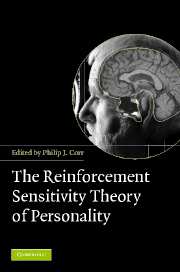Book contents
- Frontmatter
- Contents
- List of abbreviations
- List of figures
- List of tables
- List of contributors
- Preface
- 1 Reinforcement Sensitivity Theory (RST): introduction
- 2 The neuropsychology of fear and anxiety: a foundation for Reinforcement Sensitivity Theory
- 3 Animal cognition and human personality
- 4 The behavioural activation system: challenges and opportunities
- 5 Reinforcement Sensitivity Theory and personality
- 6 Reinforcement sensitivity scales
- 7 Performance and conditioning studies
- 8 Psychophysiological studies
- 9 Reinforcement Sensitivity Theory and mood induction studies
- 10 Neuro-imaging and genetics
- 11 Reinforcement Sensitivity Theory and psychosomatic medicine
- 12 RST and clinical disorders: anxiety and depression
- 13 RST and psychopathy: associations between psychopathy and the behavioral activation and inhibition systems
- 14 Behavioural activation and inhibition in social adjustment
- 15 Reinforcement sensitivity in the workplace: BIS/BAS in business
- 16 Formal and computational models of Reinforcement Sensitivity Theory
- 17 Reinforcement Sensitivity Theory: a critique from cognitive science
- 18 The contribution of Reinforcement Sensitivity Theory to personality theory
- General Index
- Index of Names
- References
1 - Reinforcement Sensitivity Theory (RST): introduction
Published online by Cambridge University Press: 31 January 2011
- Frontmatter
- Contents
- List of abbreviations
- List of figures
- List of tables
- List of contributors
- Preface
- 1 Reinforcement Sensitivity Theory (RST): introduction
- 2 The neuropsychology of fear and anxiety: a foundation for Reinforcement Sensitivity Theory
- 3 Animal cognition and human personality
- 4 The behavioural activation system: challenges and opportunities
- 5 Reinforcement Sensitivity Theory and personality
- 6 Reinforcement sensitivity scales
- 7 Performance and conditioning studies
- 8 Psychophysiological studies
- 9 Reinforcement Sensitivity Theory and mood induction studies
- 10 Neuro-imaging and genetics
- 11 Reinforcement Sensitivity Theory and psychosomatic medicine
- 12 RST and clinical disorders: anxiety and depression
- 13 RST and psychopathy: associations between psychopathy and the behavioral activation and inhibition systems
- 14 Behavioural activation and inhibition in social adjustment
- 15 Reinforcement sensitivity in the workplace: BIS/BAS in business
- 16 Formal and computational models of Reinforcement Sensitivity Theory
- 17 Reinforcement Sensitivity Theory: a critique from cognitive science
- 18 The contribution of Reinforcement Sensitivity Theory to personality theory
- General Index
- Index of Names
- References
Summary
The Reinforcement Sensitivity Theory (RST) of personality is a theoretical account of the neural and psychological processes underlying the major dimensions of personality. The first section of this introductory chapter traces the development of RST, from its official birth in 1970, through to Gray's highly influential 1982 The Neuropsychology of Anxiety, and on to its major revision in 2000 with the second edition of this book (co-authored with Neil McNaughton) – this section may be read as an overview tutorial of RST. The second section discusses some of the major issues facing future RST research. The third section turns attention to the question of the level of behavioural control exerted by ‘biological’ and ‘cognitive’ processes, and discusses the implications of findings from consciousness studies for conceptualizing the role of these processes in RST.
Past and present
At the time of writing (2006), most empirical studies continue to test the unrevised (pre-2000) version of RST. But, in many crucial respects, the revised (2000) theory is very different, leading to the formulation of new hypotheses, some of which stand in opposition to those generated from the unrevised theory. This reluctance, or slowness, to adopt the new model is, no doubt, motivated as much by unfamiliarity and research inertia as it is by a careful evaluation of the merits of both versions. But there may be a different reason for this state of affairs, and one that may continue to prevail in the RST research.
- Type
- Chapter
- Information
- The Reinforcement Sensitivity Theory of Personality , pp. 1 - 43Publisher: Cambridge University PressPrint publication year: 2008
References
- 77
- Cited by



